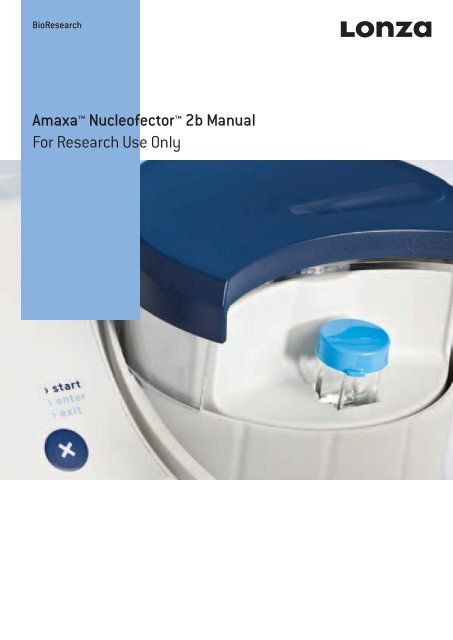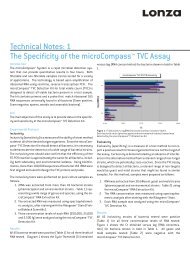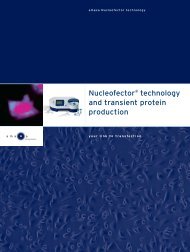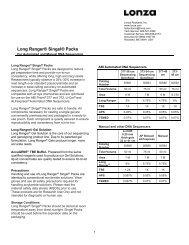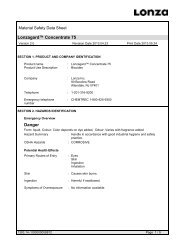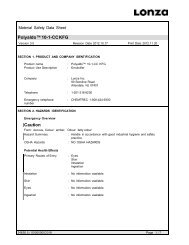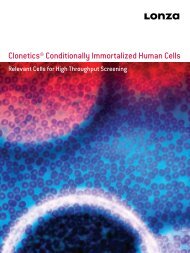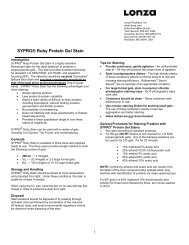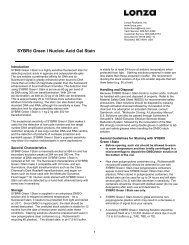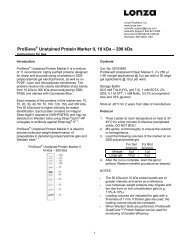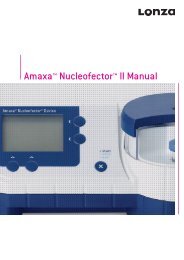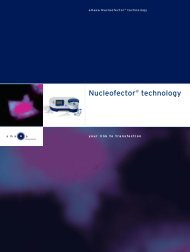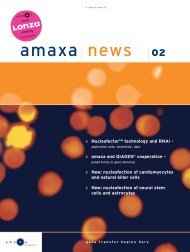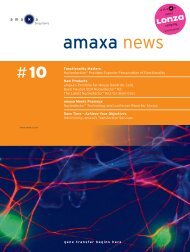Amaxa™ nucleofector™ 2b manual - lonza
Amaxa™ nucleofector™ 2b manual - lonza
Amaxa™ nucleofector™ 2b manual - lonza
- TAGS
- manual
- lonza
- bio.lonza.com
Create successful ePaper yourself
Turn your PDF publications into a flip-book with our unique Google optimized e-Paper software.
BioResearch<br />
Amaxa Nucleofector <strong>2b</strong> Manual<br />
For Research Use Only
The purchase of the Nucleofector <strong>2b</strong> conveys to the buyer<br />
the non-transferable right to use the system as well as<br />
Lonza’s proprietary Nucleofector Technology for research<br />
conducted by the buyer (whether the buyer is an academic<br />
or for-profit entity). For further details about the license<br />
please refer to chapter 5.0.
Content<br />
1 The Amaxa Nucleofector Technology 4<br />
2 Operating Instructions 6<br />
2.1 Restrictions 6<br />
2.2 Maintenance 6<br />
2.3 Safety Instructions – Please Read Carefully 7<br />
2.4 Waste Disposal 8<br />
2.5 Nucleofector <strong>2b</strong> Device Components 8<br />
2.6 Set-up Instructions 8<br />
2.7 Instructions for Using the Nucleofector <strong>2b</strong> Device 9<br />
2.7.1 Main menu and program execution 9<br />
2.7.2 Selection of Nucleofector Programs by program code – “Free Program Choice” 9<br />
2.7.3 Selection of Nucleofector Programs by name of cell type – “Cell Type List” 9<br />
2.7.4 Selection and storage of Nucleofector Custom Programs 10<br />
2.7.5 Program execution 11<br />
2.8 Additional Nucleofector <strong>2b</strong> Settings and Options 11<br />
2.8.1 Change of standard settings 11<br />
2.8.2 Motor 11<br />
2.8.3 Display contrast 11<br />
2.8.4 Beep on/off 11<br />
2.8.5 Change of start mode 11<br />
2.8.6 Language 12<br />
2.8.7 Software version 12<br />
2.8.8 Upgrading program software 12<br />
2.8.9 Serial number 12<br />
3 Troubleshooting 13<br />
4 Nucleofector <strong>2b</strong> Device Error Codes 14<br />
5 Purchaser Notification 16<br />
6 Appendix 17
BioResearch<br />
Amaxa Nucleofector <strong>2b</strong> Manual<br />
1 The Amaxa Nucleofector Technology<br />
Since its introduction in 2001, Amaxa Nucleofector Technology has<br />
transformed transfection. Nucleofection has proven to be a reliable and<br />
reproducible easy-to-use technology, suited to a wide variety of applications.<br />
An ever increasing number of publications in a wide range of research<br />
areas refl ect how Nucleofector Technology is driving research in numerous<br />
cell types and applications. Nucleofector Technology provides an answer<br />
to almost every transfection challenge.<br />
How it works<br />
Nucleofector Technology is based on two unique components, the<br />
Nucleofector Device that delivers the specifi cally optimized electrical<br />
parameters and Nucleofector Kits, which contain specifi c Nucleofector<br />
Solutions. As part of Nucleofector Technology, Lonza provides cell-type<br />
specifi c Optimized Protocols for many diff erent cell lines and primary cells.<br />
Transfection of any cell<br />
With over 160 protocols optimized by Lonza’s R&D team for cell lines<br />
and primary cells and more than 690 entries in the online cell database,<br />
Nucleofector Technology is clearly the transfection method-of-choice for<br />
any diffi cult-to-transfect cell type.<br />
4<br />
Transfection of any substrate<br />
Nucleofector Technology off ers high fl exibility within applications,<br />
since the same transfection parameters apply for almost all substrates.<br />
DNA vectors, RNA duplexes, and peptides can be transfected using our<br />
sophisticated transfection protocols. This makes Nucleofection an ideal<br />
tool for providing answers to scientifi c questions in over-expression<br />
studies, gene silencing approaches, protein expression, generation of<br />
stable clones and many more applications besides.<br />
The Nucleofector <strong>2b</strong> depicts an excellent tool for transfection of hardto-transfect<br />
cell lines and primary cells. As the device uses standard<br />
aluminum cuvettes transformation of bacteria is also possible. Based<br />
on the well established Nucleofector Technology this systems comes<br />
with 160 optimized protocols for various cell lines and primary cells. For<br />
further details visit our online database.<br />
www.<strong>lonza</strong>.com/cell-database
The Nucleofector <strong>2b</strong> Device<br />
If no Amaxa Optimized Protocol for your cell line of interest is available,<br />
we off er a Cell Line Optimization Nucleofector Kit enabling you to easily<br />
adapt the Nucleofector Technology for your specifi c cell line.<br />
For fi ne-tuning after the optimization process, please contact our<br />
Scientifi c Support Teams<br />
Europe<br />
Phone + 49 221 99199 400<br />
E-mail scientifi c.support.eu@<strong>lonza</strong>.com<br />
North America<br />
Phone 800 521 0390 (toll free)<br />
E-mail scientifi c.support@<strong>lonza</strong>.com<br />
5<br />
1
BioResearch<br />
Amaxa Nucleofector <strong>2b</strong> Manual<br />
2 Operating Instructions<br />
2.1 Restrictions<br />
Medical use restrictions<br />
The Nucleofector Technology is intended for research and investigational<br />
use by professionals only. Please note that Lonza’s Nucleofector Technology<br />
is not intended to be used for diagnostic purposes, for testing or<br />
treatment in humans.<br />
License statement<br />
Lonza is holder of various patents, patent applications, copyrights and<br />
technical and scientifi c experience with respect to Nucleofector Technology.<br />
Use of Lonza’s Nucleofector Technology and/or related software<br />
requires a license from Lonza.<br />
Purchasers are granted a non-exclusive, non-transferable license for a<br />
limited use of Lonza’s Nucleofector Technology and related software for<br />
research purposes, the terms of which are disclosed in detail in chapter<br />
5.0. Certain commercial application is allowed under Lonza’s license for<br />
for-profi t-entities.<br />
For license information contact Lonza Cologne GmbH:<br />
Phone + 49 221 99199 0<br />
E-mail ip.cologne@<strong>lonza</strong>.com<br />
6<br />
2.2 Maintenance<br />
The Nucleofector <strong>2b</strong> Device requires very little maintenance to assure<br />
reliable operation. To clean and disinfect the case, fi rst unplug the power<br />
supply. Use a damp cloth to wipe down the outer case (water or 70–80 %<br />
ethanol). Avoid wetting the cuvette holder within the cuvette carousel of<br />
the device.<br />
The Nucleofector <strong>2b</strong> Device has been designed for use under a sterile<br />
hood with or without UV radiation source. Prolonged exposure of the outer<br />
casing to UV light will lead to discoloration with no functional impairment<br />
of the Nucleofector Device. When laminar fl ows are sterilized on a regular<br />
basis by UV radiation overnight we recommend protection of the device by<br />
appropriate shielding or removal during extended UV exposure.<br />
The Nucleofector <strong>2b</strong> Device is protected by two main fuses. Both are inside<br />
a receptacle incorporated in the inner power socket (see Figure 2, page 8).<br />
In case of a blown fuse, you can easily replace it. Disconnect the<br />
Nucleofector <strong>2b</strong> Device from power and insert a small fl at screwdriver into<br />
the slot on the right-hand side of the receptacle to pull it open. To function,<br />
both the upper and lower part of the receptable must hold working fuses<br />
in the inner positions. Blown fuses can usually be identifi ed by molten<br />
interrupted wires inside the glass tube. Only use T630mA or L250V fuses<br />
to substitute blown fuses.
2.3 Safety Instructions – Please Read Carefully<br />
This symbol means that there is a risk of electric shock.<br />
An electric shock could cause death or personal injury.<br />
The Nucleofector <strong>2b</strong> Device has been certified by international safety<br />
standards and is safe to use when operated in accordance with this<br />
<strong>manual</strong>.<br />
This device is designed to deliver variable high voltage electrical<br />
impulses for the purpose of introducing nucleic acids into eukaryotic and<br />
prokaryotic cells.<br />
These electrical impulses can be deadly.<br />
Therefore, use this device with care and take the following<br />
precautions:<br />
– Only use the device once you have read and understood the<br />
Nucleofector <strong>2b</strong> Manual. The <strong>manual</strong> should be accessible for all<br />
users. Make sure that each potential user reads and understands it.<br />
– Do not open the device. The device does not contain user-serviceable<br />
parts. Under no circumstances should circuit components be interfered<br />
with, as they can deliver an electric shock even when system is not<br />
in operation.<br />
– Do not alter the device in any manner.<br />
– Do not obstruct the movement of the carousel of the Nucleofector<br />
Device.<br />
– Only use the device when it is set on top of a safe, plain and stable<br />
table or bench.<br />
– Place the device such that easy removal of the power cord is possible<br />
at any time.<br />
– Do not expose the device to a humid environment.<br />
– The device shall not be exposed to direct sunlight nor be placed in a<br />
hot environment.<br />
– The device is not approved for use in fire or explosion endangered<br />
areas, nor for use with inflammable or explosive media.<br />
– Employ precautions against great impact and vibration in moving and<br />
transporting the Nucleofector <strong>2b</strong> Device.<br />
– Use the device with Lonza’s certified Nucleofector Solutions and<br />
Lonza certified cuvettes only. Use of any other solution or cuvettes<br />
from any other source than Lonza will preclude all warranty and<br />
liability claims.<br />
7<br />
– Standard Nucleofector Solutions and 96-well Nucleofector Solutions<br />
respectively 4D-Nucleofector Solutions or HT-Nucleofector Solutions<br />
are not compatible. Please do not use the Nucleofector <strong>2b</strong> Device<br />
with these solutions. Unpack the cuvettes just prior to the experiment.<br />
Make sure that the outer contact areas are dry.<br />
– If any fluid has been spilled in the close vicinity of the Nucleofector <strong>2b</strong><br />
Device, safety may be compromised. Ensure that no fluid has been in<br />
contact with or entered the device.<br />
– If any fluid has been spilled at the device, the safety may be<br />
compromised. To confirm that the use of the device is safe, contact<br />
Lonza Scientific Support for actions or precautions.<br />
– Never place any foreign object on the device to avoid the risk of<br />
equipment damage.<br />
– Do not enter or place foreign objects in the carousel area of the<br />
Nucleofector <strong>2b</strong> Device.<br />
– If any foreign object has entered the Nucleofector <strong>2b</strong> Device, safety<br />
may be compromised. To confirm that the use of the device is safe,<br />
contact Lonza Scientific Support for actions or precautions.<br />
– If the Nucleofector <strong>2b</strong> Device has been damaged, ensure that the<br />
device can not be used by any personnel and contact Lonza Scientific<br />
Support for assistance.<br />
– All service shall be performed by Lonza authorized personnel only.<br />
– Handling of device parts that has the possible risk of sample<br />
contamination shall always be performed with protective gloves and<br />
any disposal of such parts must be according to Federal, state or local<br />
procedures for clinical waste handling and disposal. Use secure leak<br />
proof containers and avoid unprotected handling of such parts.<br />
Lonza Cologne disclaims all warranties and shall in no event be liable for<br />
any kind of damages caused by or arising out of any operation or use in<br />
violation of the above safety and handling instructions.<br />
2
BioResearch<br />
Amaxa Nucleofector <strong>2b</strong> Manual<br />
2.4 Waste Disposal<br />
Disposal of consumables from Nucleofector Kits (cuvettes, pipettes<br />
and Nucleofector Solutions): Discard cuvettes, pipettes and expired<br />
Nucleofector Solution residuals in a biohazard container. Refer to your<br />
local waste management organization and to the relevant laboratory<br />
safety instructions for proper disposal practices.<br />
2.5 Nucleofector <strong>2b</strong> Device Components<br />
The Nucleofector <strong>2b</strong> Device is delivered with the following components:<br />
– 1 Nucleofector <strong>2b</strong> Device<br />
– 1 Power cord<br />
– 1 Nucleofector <strong>2b</strong> Manual<br />
Front panel of the Nucleofector <strong>2b</strong> Device<br />
Figure 1<br />
2 3 8<br />
1 5 6 10 4 7<br />
9<br />
1 Power button<br />
2 Graphic display<br />
3 “Up” button<br />
4 “Down” button<br />
5 Functional button “menu”<br />
6 Functional button “options”<br />
7 “X” button with start, exit or enter function<br />
8 Automatic cuvette carousel<br />
9 Cuvette holder<br />
10 Chipcard slot<br />
8<br />
Rear side of Nucleofector <strong>2b</strong> Device<br />
Figure 2<br />
11 Fuse<br />
12 Power cord receptacle<br />
2.6 Set-up Instructions<br />
1. Remove all packing material.<br />
2. Attach the power cord to the receptacle on the rear side of the<br />
Nucleofector <strong>2b</strong> Device (12) and plug it into an appropriate electrical<br />
outlet. The device will automatically be in the stand-by mode. Turn on<br />
the device by pressing the power button in the upper left corner of<br />
the front panel (1). The device performs a self test accompanied by<br />
a short intro in the graphic display (2). After powering up, the display<br />
shows the main menu “Free Program Choice” (Figure 3.). The start<br />
mode can be changed to the last program used as described in chapter<br />
2.8.5.<br />
Figure 3<br />
11 12
2.7 Instructions for Using the Nucleofector <strong>2b</strong> Device<br />
2.7.1 Main menu and program execution<br />
The Nucleofector <strong>2b</strong> Device offers two separate ways for program<br />
selection. Programs can either be chosen by direct selection of the<br />
program code, e.g., A-023, in the “Free Program Choice” mode (Figure 3). As<br />
a convenient alternative, programs can also be selected by cell type<br />
code using the “Cell Type List” (Figure 4). This list is divided in three<br />
consecutive sections:<br />
1. All programs from currently available Amaxa Optimized Protocols are<br />
filed under the specific cell type name in alphabetical order (Figure 4).<br />
2. This alphabetical list for eukaryotic cells is followed by a list of<br />
programs for the transformation of bacteria. For details please contact<br />
Lonza’s Scientific Support Teams and ask for the latest developments<br />
and experimental support.<br />
3. The last section comprises custom programs (see 2.7.4.) in<br />
chronological order. In addition, custom programs can be found in the<br />
“Custom Programs” mode. You can switch program modes by pressing<br />
the functional button “menu” (5) several times until the required<br />
program mode appears and confirm by pressing the functional button<br />
“go” (6).<br />
Note<br />
Only custom programs can be stored or deleted by the user. The program<br />
codes of the Nucleofector <strong>2b</strong> Device consist of two parts: a one-digit<br />
alphabetical code followed by a three-digit numerical code, e.g., U-025<br />
(Figure 4).<br />
Mode Program can be<br />
edited deleted<br />
“Free Program Choice” Yes No<br />
“Cell Type List” (pre-programmed) No No<br />
“Custom programs” Yes Yes<br />
9<br />
2.7.2 Selection of Nucleofector Programs by program code –<br />
“Free Program Choice”<br />
1. Turn on the Nucleofector <strong>2b</strong> Device by using the power button (1).<br />
Nucleofector <strong>2b</strong> Device starts in the “Free Program Choice” mode<br />
(Figure 3). If it does not start in the “Free Program Choice” press the<br />
functional button “menu” (5) repeatedly until “Go to Free Program<br />
Choice” appears and confirm this pressing the functional button<br />
“go” (6).<br />
2. The alphabetical first digit blinks. Choose the appropriate letter of the<br />
program code by using the “Up” and “Down” buttons (3,4). Then move the<br />
cursor with the functional buttons “” (5,6) to the numerical<br />
three-digit code. Select the appropriate number of the program<br />
code with the “Up” and “Down” buttons (3,4). Continual pressing<br />
of the “Up” and “Down” buttons allows for fast scrolling of choices.<br />
Your Nucleofector <strong>2b</strong> Device is now ready for program execution<br />
(see 2.7.5).<br />
3. Exit this mode by pressing the “X” button.<br />
2.7.3 Selection of Nucleofector Programs by name of cell type –<br />
“Cell Type List”<br />
1. Turn on the Nucleofector <strong>2b</strong> Device by using the power button (1). If<br />
the Nucleofector <strong>2b</strong> Device starts in the “Free Program Choice” mode<br />
(Figure 3), exit this mode by pressing the “X” button (7). Press the<br />
functional button “menu” (5) several times until “Go to Cell Type List”<br />
appears and confirm this choice by pressing the functional button<br />
“go” (6).<br />
2. Choose the appropriate program for your cell type (Figure 4) by<br />
navigating through the pre-programed list using the “Up” and “Down”<br />
buttons (3, 4). The programs are displayed in alphabetical order. The list<br />
is organized by first the cell name (e.g., T cells), descriptions of the species<br />
and further details of the cell type are given in line three. Line five shows<br />
the corresponding program itself. In cases where two or more programs are<br />
available, the fourth line indicates the specificity of the program such as for<br />
higher transfection efficiency or for higher cell viability. Your Nucleofector<br />
<strong>2b</strong> Device is now ready for program execution (see 2.7.5).<br />
Figure 4<br />
2
BioResearch<br />
Amaxa Nucleofector <strong>2b</strong> Manual<br />
2.7.4 Selection and storage of Nucleofector<br />
Custom Programs<br />
The Nucleofector <strong>2b</strong> Software provides the option to add programs to the<br />
Cell Type List by storing the appropriate program under a new individual<br />
name. In this way information about an optimized program for a particular<br />
cell type can be stored directly in the Nucleofector <strong>2b</strong> Device.<br />
1. Turn on the Nucleofector Device by using the power button (1).<br />
If the Nucleofector <strong>2b</strong> Device starts in the “Free Program Choice”<br />
mode (Figure 3), exit this mode by pressing the “X” button (7).<br />
2. Press the functional button “options” (6). Select “new” from the popup<br />
menu by using the “Up” and “Down” buttons (3, 4) and confirm with<br />
“X” button (7). The menu jumps to a free custom program memory<br />
location (Figure 5).<br />
Figure 5<br />
3. The cursor blinks at the starting position. Scroll through the character<br />
set by using the “Up” and “Down” button (3,4) to enter the desired text<br />
and move to the consecutive character positions with the functional<br />
button “>>” (6). By using the functional button “” (6) to the<br />
numerical three-digit code. Select the appropriate program number<br />
with “Up” and “Down” buttons (3,4). In order to save the custom<br />
program press the “X” button (7) and choose “yes” in the arising<br />
window by pressing the left functional button (5). Exit and save by<br />
pressing the “X” button (7).<br />
5. Saved custom programs can be selected by navigating through the<br />
“Cell Type List” using the “Up” and “Down” buttons (3, 4). Custom<br />
programs are listed after the pre-programmed cell-type list, in<br />
chronological order. Additionally, for faster access the programs are<br />
listed separately in the “Custom Programs” mode.<br />
10<br />
6. In order to modify or delete a saved custom program, navigate to the<br />
corresponding program in the “Cell Type List” or “Custom Program”<br />
mode using the “Up” and “Down” buttons (3, 4) and subsequently<br />
press the functional button “options” (6). Move to “Edit” or “Delete”<br />
in the popup menu (Figure 6) using the “Up” and “Down” buttons<br />
(3, 4) and select it with the “X” button (7). In case you want to edit your<br />
program, you may now modify any position of the custom program<br />
entry by the procedure described above for custom program entry. To<br />
leave the popup menu without any action press the functional button<br />
”options” (6) again.<br />
Figure 6<br />
7. Leave the edit or delete mode, save the changes, and return to the<br />
main menu by pressing the “X” button (7).<br />
8. Your Nucleofector <strong>2b</strong> Device is now ready for program execution<br />
(see 2.7.5).
2.7.5 Program execution<br />
1. After you have chosen the correct program, place the closed cuvette<br />
filled with 100 µl Nucleofection Sample in the cuvette holder (9).<br />
For program execution press the “X” button (7). The cuvette carousel<br />
(8) closes automatically (see 2.7.2) and the program is executed.<br />
Subsequently, the carousel automatically rotates back to reveal<br />
the cuvette. “OK” will appear on the display if the program has been<br />
successfully completed. After addition of pre-warmed medium (see<br />
Optimized Protocols for further details) remove the Nucleofection<br />
Sample from the cuvette with the plastic pipette provided in the<br />
Nucleofector Kit. Discard cuvettes after one use.<br />
Note<br />
Only use fresh Lonza certified cuvettes, which have passed rigorous<br />
quality tests. Use of both uncertified cuvettes and re-use of Lonza<br />
certified cuvettes (after even one use), impairs experimental results,<br />
proper function of the device and risks damaging of the Nucleofector<br />
<strong>2b</strong> Device itself.<br />
2. Press the “X” button (7) to acknowledge. The device can be re-used<br />
immediately after the last program execution.<br />
3. In case the device was unable to execute a program or the program<br />
was not completed successfully, the display will indicate the error type<br />
and error code. For more information on specific errors, see chapter 3<br />
4. To continue working, press the “X” button (7) to acknowledge the error<br />
message. The device can then be re-used immediately.<br />
5. When you have finished working, please remove the last cuvette from<br />
the cuvette holder (9) and switch off the Nucleofector <strong>2b</strong> Device by<br />
pressing the power button (1).<br />
Note<br />
The Nucleofector Programs available correspond to the list of Amaxa<br />
Optimized Protocols that are provided with the Nucleofector Kits which<br />
can be downloaded at www.<strong>lonza</strong>.com/protocols. If the Nucleofector<br />
Program you want to apply is not available on your device, please contact<br />
the Lonza Scientific Support Team to receive a chipcard to update the<br />
program software.<br />
11<br />
2.8 Additional Nucleofector <strong>2b</strong> Settings<br />
and Options<br />
2.8.1 Change of standard settings<br />
In order to change the settings of your Nucleofector <strong>2b</strong> Device, press the<br />
functional button “menu” (5). By repeatedly pressing the button “menu”<br />
(5) you will first pass the three program mode options “Go to Free Program<br />
Choice”, “Go to Cell Type List” and “Go to Custom Programs” and then be<br />
guided through the settings. To return from any sub-menu to the main<br />
menu press the “X” button (7).<br />
2.8.2 Motor<br />
The cuvette carousel (8) is connected to a motor which enables automatic<br />
movement of cuvette into position by closing and opening the cuvette<br />
holder carousel. In the menu settings you can choose between “on” for<br />
fully automated turning or “off” for <strong>manual</strong> opening and closing.<br />
Notes<br />
– In case you have switched off the motor option in the menu, you will<br />
have to rotate the carousel <strong>manual</strong>ly by 180° clockwise. The carousel<br />
must be turned completely to the blocked position so that the cuvette<br />
contacts the electrodes.<br />
– For safety reasons, the motor of the Nucleofector <strong>2b</strong> Device is<br />
equipped with a sensitive blockage detection. If closing of the<br />
carousel is hindered, e.g., by an inserted finger, the motor stops<br />
immediately and returns to its starting position. The display shows<br />
the corresponding error code (Err2 = Inappropriate or no cuvette or<br />
carousel not closed). Continue working by pressing the “X” button (7)<br />
to exit the error mode.<br />
2.8.3 Display contrast<br />
In order to optimize readability of the display, change of the display<br />
contrast is possible by pressing the “Up” and “Down” buttons (3,4). The<br />
change has to be confirmed by pressing the functional button “set” (5).<br />
By leaving the submenu without pressing “set”, the change is reversed<br />
in order to reduce the risk of modifying the contrast in such way that you<br />
may have difficulties reading the display.<br />
2.8.4 Beep on/off<br />
The beep following the switch-on of the device and erroneous program<br />
execution can be inactivated by choosing “off” with pressing the<br />
“Up” and “Down” buttons (3,4). The default setting is “on”.<br />
2.8.5 Change of start mode<br />
The Nucleofector <strong>2b</strong> Device can either start in the “Free Program Choice”<br />
mode or with the last program used. Choose the appropriate option by<br />
pressing the “Up” and “Down” buttons (3,4). The default setting is “Free<br />
Program Choice”.<br />
2
BioResearch<br />
Amaxa Nucleofector <strong>2b</strong> Manual<br />
2.8.6 Language<br />
The Nucleofector <strong>2b</strong> Device offers a language option. The default setting<br />
is English. It can be switched to Japanese (or back to English) by pressing<br />
the “Up” and “Down” buttons (3,4). The change has to be confirmed by<br />
pressing the functional button “set” (6). By leaving the submenu without<br />
pressing “set”, the change is reversed in order to reduce the risk of modifying<br />
the language by mistake.<br />
2.8.7 Software version<br />
Press the functional button “menu” (6) to view the current software version<br />
of the Nucleofector <strong>2b</strong> Device that comprise the operating programs<br />
of your Nucleofector <strong>2b</strong> Device (for updating the program software<br />
see 2.8.8).<br />
2.8.8 Upgrading program software<br />
1. In order to upgrade the program list on your Nucleofector <strong>2b</strong> Device,<br />
insert the chipcard with the novel software version provided by Lonza<br />
into the chipcard reader slot (10) (Figure 7).<br />
2. After the Nucleofector <strong>2b</strong> Device recognizes the chipcard, confirm<br />
loading of the novel Nucleofector Software by pressing the “X”<br />
button (7).<br />
Figure 7<br />
3. The upgrade starts with a program table. Confirm by pressing the<br />
“X” button (1).<br />
4. Secondly, the list of optimized programs is loaded. Confirm again with<br />
the “X” button (1). The stored custom programs will be neither deleted<br />
nor overwritten by upgrading novel non-custom optimized programs.<br />
5. Confirm the software upgrade and return to the main menu by pressing<br />
the “X” button (1) and remove the chipcard from the chipcard reader<br />
slot.<br />
12<br />
2.8.9 Serial number<br />
Press the functional button “menu” (6) to view the serial number of your<br />
Nucleofector <strong>2b</strong> Device.
3 Troubleshooting<br />
The following troubleshooting guide may be helpful if experiments using<br />
the Nucleofector <strong>2b</strong> Device do not work as expected. The listed comments<br />
are intended to help optimize experimental conditions.<br />
Should you have any questions regarding the Nucleofector <strong>2b</strong> Device,<br />
please do not hesitate to contact Lonza’s Scientifi c Support Team<br />
Europe<br />
Phone + 49 (0)221 99199 400<br />
Fax + 49 (0)221 99199 499<br />
scientifi c.support.eu@<strong>lonza</strong>.com<br />
www.<strong>lonza</strong>.com/nucleofection-support<br />
USA<br />
Phone 800 521 0390<br />
Fax 301 845 8338<br />
scientifi c.support@<strong>lonza</strong>.com<br />
www.<strong>lonza</strong>.com/nucleofection-support<br />
Problem Possible error What happened?<br />
Low survival rate Cells remained too long<br />
in the cuvette.<br />
Cells are damaged by harvesting<br />
or through handling.<br />
Cells are stressed by<br />
culture conditions.<br />
To avoid damage to the cells, transfer cells immediately into pre-warmed medium (37°C).<br />
We recommend removing the sample from the cuvette directly after Nucleofection.<br />
Avoid severe conditions during harvesting, especially centrifugation at higher speed and overexposure to trypsin.<br />
Pipette cells smoothly. Use a plastic pipette provided in the kit for removal of cells from the cuvette.<br />
Add pre-warmed medium to the cuvette before removal of the cells.<br />
Cells should be viable and in culture for a certain number of passages. Freshly thawed cells should not be used<br />
for Nucleofection. Avoid excessive cell densities or cell confl uencies since this may negatively infl uence the<br />
viability of the cells after Nucleofection. For detailed recommendations on passage number, cell density and<br />
confl uence please refer to the individual Amaxa Optimized Protocol.<br />
Cells are stressed by centrifugation. Centrifuge at lower speed (90×g).<br />
Multiple use of cuvettes. We strongly recommend using cuvettes only once, because the electric pulses that are applied drastically reduce<br />
their quality and impair their physical integrity.<br />
Poor DNA quality. Plasmid DNA used should be of high purity. We strongly recommend the use of high quality products for<br />
plasmid purifi cation such as QIAGEN Endo Free Plasmid Kits. Do not use procedures involving phenol or<br />
chloroform treatment.<br />
Low gene transfer Plasmid amount is too low. We recommend a plasmid amount between 1–5 μg DNA per sample. If both gene transfer effi ciency and cell<br />
mortality are low, the plasmid amount can be increased up to 10 μg per sample. Increasing the DNA amount may<br />
lead to higher gene transfer effi ciencies but at the same time may result in higher cell mortality.<br />
High cell confl uency/density. Gene transfer effi ciency into many cell types is poor if the cells are too dense at the time of harvest. Please<br />
follow guidelines in the Amaxa Optimized Protocols.<br />
Too high or too low cell number in<br />
the cuvette.<br />
We recommend using 1×10 6 –5×10 6 cells per sample for cell lines and 2×10 5 –5×10 6 cells per sample for primary<br />
cells. Please refer to the Amaxa Optimized Protocol for specifi c details.<br />
Poor DNA quality. Plasmid DNA used should be of high purity. We strongly recommend the use of high quality products for<br />
plasmid purifi cation such as QIAGEN Endo Free Plasmid Kits. Do not use procedures involving phenol or<br />
chloroform treatment.<br />
13<br />
3
BioResearch<br />
Amaxa Nucleofector <strong>2b</strong> Manual<br />
4 Nucleofector <strong>2b</strong> Device Error Codes<br />
The following guide indicates possible Nucleofector Error Codes and<br />
provides suggestions to solve the problem on your own.<br />
Should these suggestions not resolve the problem, please call Lonza’s<br />
Scientifi c Support Team<br />
Europe<br />
Phone + 49 221 99199 400<br />
E-mail scientifi c.support.eu@<strong>lonza</strong>.com<br />
North America<br />
Phone 800 521 0390 (toll free)<br />
E-mail scientifi c.support@<strong>lonza</strong>.com<br />
Internet<br />
www.<strong>lonza</strong>.com/nucleofection-support<br />
If the Nucleofector <strong>2b</strong> Device has to be returned for repair, please contact<br />
our Scientifi c Support Team for shipping and warranty instructions.<br />
14<br />
Arc discharge correction<br />
Arcing is a complete or partial discharge circumventing the sample and is<br />
often accompanied by a fl ash and a noise. This problem is usually caused<br />
by imperfect cuvettes or cuvette fi lling. The Nucleofector <strong>2b</strong> Device is<br />
equipped with a hardware safety that immediately detects arc formation<br />
at its beginning to protect the cells from damage. After the arc interruption<br />
the Nucleofector <strong>2b</strong> Device resumes program execution. Normally, the<br />
program can be completed successfully (“arc discharge correction 1 or 2”)<br />
and only limited diff erences in transfection effi ciency can be observed.<br />
When repeated arc discharges within one program occurs, it might be<br />
impossible for the Nucleofector <strong>2b</strong> Device to complete program execution.<br />
In this case (“Err8 - Arc discharge”) signifi cant impacts on transfection<br />
effi ciency might be detected. Discard the possibly damaged cuvette and<br />
its contents, reset the device by pressing the “X” button (1), and repeat<br />
the experiment with a new cuvette. It is not necessary to switch off the<br />
Nucleofector <strong>2b</strong> Device.
Code Possible error What happened? Procedure<br />
Arc discharge<br />
correction 1 or 2<br />
WEAK –<br />
Re-used cuvette or inappropriate solution<br />
Err1A –<br />
Internal communication failure<br />
Err1B –<br />
Internal communication failure<br />
Err2 –<br />
Inappropriate or no cuvette or<br />
carousel not closed<br />
Err3 –<br />
Device possibly defective<br />
Err7 –<br />
Supply voltage too low<br />
Err8 –<br />
Arc discharge<br />
Err9 –<br />
Inappropriate solution, volume or cuvette<br />
Err11 –<br />
DSP error<br />
Err12 –<br />
Motor error<br />
Inappropriate cuvette or Nucleofector<br />
Solution or inappropriate volume in the<br />
cuvette or device possibly defective.<br />
Re-used cuvette or inappropriate<br />
Nucleofector Solution.<br />
Internal error or device possibly defective.<br />
Internal error or device possibly defective.<br />
Inappropriate or no cuvette. Inappropriate<br />
Nucleofector Solution or inappropriate<br />
volume. Carousel motor is switched off.<br />
Device overheated or possibly defective.<br />
Supply voltage insufficient or device has<br />
been switched off for a long time.<br />
Inappropriate cuvette or Nucleofector<br />
Solution or inappropriate volume in the<br />
cuvette or device possibly defective.<br />
Inappropriate cuvette or Nucleofector<br />
Solution or volume or device possibly<br />
defective.<br />
Device possibly generated an arc<br />
discharge. Program was automatically<br />
resumed and successfully completed.<br />
A limited impairment on efficiency and<br />
vitality has to be presumed.<br />
A weak pulse occurred. Only sub-optimal<br />
efficiency might be achieved.<br />
15<br />
No pulse generated.<br />
Pulse generated with unclear outcome.<br />
No pulse generated.<br />
Very weak pulse generated.<br />
No pulse generated.<br />
Device possibly generated an arc discharge<br />
leading to incomplete program execution.<br />
A substantial impairment on efficiency and<br />
viability has to be presumed.<br />
Device possibly generated an overcurrent.<br />
Reset device by pressing any button.<br />
Utilize sample if maximum efficiency is not<br />
essential or try again with a new sample.<br />
For further samples check if the volume in<br />
the cuvette is 100 μl.<br />
Acknowledge the error message by<br />
pressing any button; utilize the sample<br />
if maximum efficiency is not essential.<br />
Otherwise, try a new sample.<br />
Acknowledge the error message by<br />
pressing any button; try to apply program<br />
a second time. If Err1A re-occurs, switch off<br />
the device, wait for 2 seconds and switch<br />
on again.<br />
Acknowledge the error message by<br />
pressing any button; utilize sample if<br />
maximum efficiency is not essential.<br />
Otherwise, try with a new sample. If Err1B<br />
re-occurs, switch off the device, wait for<br />
2 seconds and switch on again.<br />
Check cuvette. Check type and volume<br />
of Nucleofector Solution. Cuvette can be<br />
re-applied. If carousel is not closed, close<br />
it <strong>manual</strong>ly or change motor option to “on”<br />
(see 2.7.2).<br />
Switch off the device. Wait for 2 minutes,<br />
switch on again; repeat the program with a<br />
new sample.<br />
Acknowledge the error message by<br />
pressing any button. Try again with a<br />
new cuvette.<br />
Acknowledge the error message by<br />
pressing any button. Check the volume of<br />
Nucleofector Solution. Try again with a<br />
new cuvette.<br />
Acknowledge the error message by<br />
pressing any button. Try again with new<br />
cuvette.<br />
Internal error or device possibly defective. Pulse possibly omitted. Switch the device off and on to reset.<br />
Try again with a new sample.<br />
Carousel motor failure. Motor blocked, or motor control<br />
communication defective, or device<br />
possibly defective.<br />
Acknowledge the error message by<br />
pressing any button. Try again.<br />
4
BioResearch<br />
Amaxa Nucleofector <strong>2b</strong> Manual<br />
5 Purchaser Notifi cation<br />
The purchase of the Nucleofector <strong>2b</strong> conveys to the buyer a nontransferable,<br />
non-exclusive license without the right to grant sublicenses<br />
limited for the use of Lonza’s proprietary Nucleofector Process and<br />
Method.<br />
The license is limited to research use only. The license does not include<br />
the right to use the purchased device, its components or materials for any<br />
Commercial Purpose as defi ned below. Not withstanding the foregoing,<br />
the buyer shall be allowed to use the licensed process in combination<br />
with the purchased device to perform services internally for affi liates,<br />
subsidiaries, sections, departments or scientifi c collaborators, provided<br />
that such services are not for any Commercial Purpose.<br />
Under no circumstances shall the licensed process and/or the purchased<br />
device be used for testing or treatment in humans. The buyer acknowledges<br />
that the licensed process and/or the purchased device are not diagnostic<br />
or therapeutic tools and that they shall not be used as an accessory or<br />
complement to such tools.<br />
Commercial purposes as used herein means any activity done by a party<br />
for monetary or other consideration and may include, but is not limited<br />
to: (1) use of the product or its components in manufacturing; (2) use of<br />
the product or its components to provide a service, information, or data;<br />
(3) use of the product or its components for therapeutic, diagnostic or<br />
prophylactic purposes; or (4) resale of the product or its components,<br />
whether or not such product or its components are resold for use in<br />
research. The buyer is not licensed to manufacture, copy, reproduce,<br />
transmit, distribute, sell, lease, transfer or sublicense the licensed process<br />
and/or the purchased device.<br />
For information on purchasing a license to this product for purposes<br />
other than research, contact our Licensing Department:<br />
Phone + 49 221 99199 0<br />
E-mail ip.cologne@<strong>lonza</strong>.com<br />
16<br />
Representations and warranties<br />
Lonza represents and warrants that, it is not aware of any legal defi ciencies<br />
of the Patents and that to its knowledge it has the right to dispose of the<br />
patents. Lonza further represents and warrants that it has no knowledge<br />
of any rights of third parties which have priority over the patents and that<br />
the inventors of the invention falling under the patents have transferred<br />
all rights and entitlements to Lonza and that accordingly Lonza has full<br />
power and authority to grant the license provided hereunder.<br />
Lonza does not warrant that the information and data pertaining to the<br />
licensed process and/or the purchased device is correct and without<br />
defects, that the use of such information or data is adequate for the use<br />
of the licensed process and/or the purchased device or that the technical<br />
information or data for the licensed process and/or the purchased device<br />
is complete.<br />
Lonza does not warrant either that the use of the license does not infringe<br />
third parties’ rights or does not cause damages to third parties. Any liability<br />
for later invalidation or lapse of the patents is excluded.
6 Appendix<br />
Power supply<br />
Power consumption 50 VA<br />
Technical data<br />
100–240 VAC<br />
50–60 Hz<br />
self-regulating<br />
Fuse Protection T630 mA, L250V<br />
Temperature range +15°C to +40°C, non-condensing<br />
Altitude < 2000 m above sea level<br />
Safety class<br />
EN 61010-1<br />
UL 61010A-1<br />
IP 20<br />
Weight 2.8 kg<br />
6.2 lb<br />
Dimensions (w×d×h) 30×23×11 cm<br />
11.8×9.6×4.3 in<br />
Manufacturing date The manufacturing year is encoded by the second and third digit of the serial number, e.g., serial number x11xxxxx was manufactured in 2011.<br />
17<br />
5<br />
6
BioResearch<br />
Amaxa Nucleofector <strong>2b</strong> Manual<br />
Notes<br />
18
www.<strong>lonza</strong>.com<br />
www.<strong>lonza</strong>.com/specifications.html<br />
Contact Information<br />
Online Ordering<br />
https://shop.<strong>lonza</strong>.com<br />
Customer Service<br />
North America<br />
800 638 8174 (toll free)<br />
Europe<br />
+ 32 87 321 611<br />
International<br />
Contact your local Lonza Distributor<br />
+1 301 898 7025, ext. 2400<br />
Scientific Support<br />
North America<br />
800 521 0390 (toll-free)<br />
scientific.support@<strong>lonza</strong>.com<br />
Europe<br />
+49 221 99199 400<br />
scientific.support.eu@<strong>lonza</strong>.com<br />
International<br />
scientific.support@<strong>lonza</strong>.com<br />
International Offices<br />
Australia +61 3 9550 0883<br />
Austria 0800 201 538 (toll free)<br />
Belgium +32 87 321 611<br />
Brazil +55 11 5641 3325<br />
Denmark 808 83 159 (toll free)<br />
France 0800 91 19 81 (toll free)<br />
Germany 0800 182 52 87 (toll free)<br />
India +91 22 4342 4000<br />
Italy 800 789 88 (toll free)<br />
Japan +81 3 5566 0612<br />
Poland +48 781 120 300<br />
Singapore +65 6521 4379<br />
Spain 900 963 298 (toll free)<br />
Sweden 020 790 220 (toll free)<br />
Switzerland 0800 83 86 20 (toll free)<br />
The Netherlands 0800 022 4525 (toll free)<br />
United Kingdom 0808 234 97 88 (toll free)<br />
Lonza Cologne GmbH – 50829 Cologne, Germany<br />
For research use only. Not for use in diagnostic procedures.<br />
Manufacturer and distributor information: Nucleofector <strong>2b</strong> Device is<br />
manufactured by Lonza Cologne GmbH, Nattermannallee 1, 50829<br />
Cologne, Germany and distributed in the US by Lonza Walkersville, Inc.<br />
(8830 Biggs Ford Road, Walkersville, MD 21793).<br />
The use of this product, alone or in combination with materials and/or<br />
methods of others, may require a license from a third party. User shall<br />
be fully responsible for determining whether and from whom it requires<br />
such license and for obtaining such license.<br />
The Amaxa Nucleofector Technology, comprising Nucleofection<br />
Process, Nucleofector Device, Nucleofector Solutions, Nucleofector<br />
96-well Shuttle System and 96-well Nucleocuvette Plates and<br />
Modules is covered by patent and/or patent pending rights owned by<br />
Lonza Cologne GmbH.<br />
Amaxa, Nucleofector, Nucleofection, Nucleocuvette, maxGFP and<br />
96-well Shuttle are either registered trademarks or trademarks of<br />
Lonza Cologne GmbH in Germany and/or the U.S. and/or other countries.<br />
Other product and company names mentioned herein are the trademarks<br />
of their respective owners.<br />
Amaxa Nucleofector Kits contain a proprietary nucleic acid coding for<br />
a proprietary copepod protein fluorescent protein intended to be used<br />
as a positive control with Lonza products only. Any use of the proprietary<br />
nucleic acid or protein other than as a positive control with a Lonza<br />
product is strictly prohibited. Use in any other application requires a<br />
license from Evrogen. To obtain such a license, please contact Evrogen<br />
at license@evrogen.com.<br />
The information contained herein is believed to be correct and corresponds<br />
to the latest state of scientific and technical knowledge. However,<br />
no warranty is made, either expressed or implied, regarding its accuracy<br />
or the results to be obtained from the use of such information and no<br />
warranty is expressed or implied concerning the use of these products.<br />
The buyer assumes all risks of use and/or handling. No statement is<br />
intended or should be construed as a recommendation to infringe any<br />
existing patent.<br />
© Copyright 2011, Lonza Cologne GmbH. All rights reserved.<br />
MN-Nucleo2B 11/11 CD-MN029


